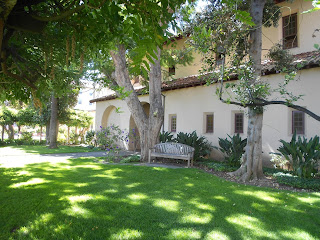 |
| Mission Santa Clara |
The story of the California Spanish missions started with the founding in 1769 of the very first mission in San Diego, Mission Basilica San Diego de Alcala. That first mission was founded by Father Junipero Serra. The second mission in the string that would eventually total twenty-one was the mission at Monterey California which soon after was relocated to Carmel California and named Mission San Carlos Borroméo del río Carmelo. It's also referred to often as the Carmel Mission and is located along the Carmel River. The last mission constructed and the northernmost is Mission San Francisco de Solano located in the town of Sonoma.
 |
| Mission Santa Clara Cross |
Mission Santa Clara de Asis was the eighth Spanish mission built in Alta California. Santa Clara University where the mission is currently located has the distinction of being the first college in Alta California. The Santa Clara Mission college was established in 1828. When the Spaniards were driven out of Alta California in the 1820's due to the Mexican Revolution, the missions were secularized and went through a period of decline both in missionary work as well as upkeep of the structures. When the United States took possession of Alta California as a result of the Mexican American War, the missions found new life. The new American presence in California left a lot of questions to be answered, most notably was the question of who owned what since so many land grants had been given out by the Mexican government. In 1851 the church petitioned the U.S. government to return original mission holdings, much of which had been ceased by the Mexicans. As a result, the U.S. did return a bit over 1,000 acres to the church.
 |
| Mission grounds |
An interesting fact about Mission Santa Clara was that the mission was ruined and rebuilt six times. This was due to a series of fires and earthquakes. Even though there were so many of these disruptions the mission was never abandoned. The current location is actually the fifth home for the mission which originally was built on the banks of the Guadalupe River near today’s intersection of U.S.Highway 101 and the Mineta International Airport runway. Eventually the church was built on higher ground where it resides today. The last fire that destroyed the mission occurred in 1925 and destroyed the church that was built in 1828. The present mission was rebuilt in 1929 and was consecrated the same year. A college on the site was reestablished in 1851, just one year after California gained statehood and that institution grew into today's Santa Clara University.
Mission Santa Clara de Asis is today at the very heart of Santa Clara University. This private non-profit Jesuit institution of higher learning has over 150 years of history. Actually, two colleges appeared on the scene shortly after the gold rush and statehood. Today's Santa Clara University is one and the other established in 1851 was California Wesleyan College. The latter received the first state charter and Santa Clara University soon afterward. In 1912, the name Santa Clara College was changed to Santa Clara University. The school was an all male institution until 1961.
 |
| 130 year old wisteria vine at Santa Clara Mission |
Another interesting site you'll see while exploring the Santa Clara University campus is the Ricard Observatory. The first telescope was in operation in 1890 and today the existing observatory was built between 1924-1928. The observatory is named for Jerome Sixtus Ricard, S.J.. Father Ricard was famous for making a connection between sunspot activity and terrestrial weather.
Two additional articles we've published on Western Trips which you'll find interesting are Mission San Juan Batista and the Sonoma Mission in Sonoma California.
Two excellent books on the Spanish missions are The Spanish Missions of California by author Megan Gendell and The California Missions: A Complete Pictorial History and Visitor's Guide by the Editors of Sunset Books.
(Photos from author's private collection)

